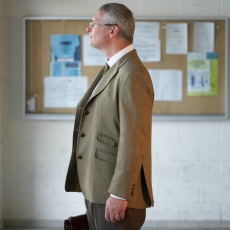My office is on the first floor of the education building. I have spent 27 years in this building. Unless I have a meeting in another department, I rarely go upstairs. Recently, however, I started a daily routine of climbing the four sets of staircases in the building. Trying to slow the progression of osteoporosis in my right hip, I go up one set and down another three times as I make my way around the building. This physical activity has given me a chance to engage in some mental reflection. Here I will briefly share five observations on a career spent teaching in higher education with an eye toward encouraging newer faculty to achieve longevity in the profession.
1. Adaptability is key.
On the first day of stair climbing, I passed by the classroom where I taught my very first class as a newly “hooded” faculty member. As I looked in the room, a smile came across my face as I thought of those thirty graduate students—most of whom were older than I was. While I remained at the university, they went on to become school principals, district superintendents, and curriculum coordinators. Seeing this classroom now made me think about the changes in my teaching. The large chalkboard once mounted on the wall is long gone. Even though I always liked using chalk (and had a special stainless steel holder for it), other tools have definitely replaced the infamous dust producer. Technology has been the greatest change in my delivery of instruction. Yet no matter what the innovation or new requirement (e.g., reporting assessment data, using iPads in the classroom, etc.), maintaining flexibility and being open to alternative approaches will serve faculty well over time.
2. Become resourceful.
As I walked the hallways, I noticed the office directories at the main entrance to each department. So familiar, these are easily ignored. Actually looking at them each day reminded me that people are the most valuable resource available to us as faculty. Whose expertise complements ours? Whose interests are similar to ours? With whom can we bounce off ideas for teaching a new class preparation?
Furthermore, a large part of being successful in any professional endeavor is knowledge of whom to call for which dilemma. Aging in the profession reinforces that knowing where to get help surpasses knowing all the answers. Sometimes teaching faculty must let pride subside and not hesitate to find out where to get assistance. As we seek out and use the multitudinous resources that surround us on a college campus, we can become more effective faculty members.
3. Connect across departments.
On my fifth day of stair climbing, I saw two colleagues from another department on the second floor. I had last seen them on campus the previous semester. From the brief hallway encounter, they asked me to help with a research project. Had I not been upstairs, this opportunity may have not been extended. My simple exercise strategy prompted me to realize (again) how isolation within one’s own department may stifle growth and development. This incident also reminded me of the need for faculty to be visible and available. On several other recent self-guided building tours, I have seen past and present students in the halls or on the stairs. This too strengthens our connections and enhances efficacy.
4. Be observant.
On each stairwell there are bulletin boards. Opportunities abound for campus involvement. In the deluge of email messages, it is easy to overlook some of these options that are available to us on campus. Even if not personally interested, sharing posted information with students is a possibility. Additionally, the content of stairwell bulletin boards contains significant clues about what is currently relevant to students. Flyers with information on upcoming comedy acts and anxiety support groups serve to remind us of the lives outside the classroom that our students lead. We can then incorporate this information into lesson planning and perhaps better reach students.
5. Take regular breaks.
The whole stair-climbing experience has reminded me of the importance of building in short breaks during the workday. After each stair climbing endeavor, I have returned to my office and computer in a more refreshed state of mind. I gained a new perspective on my work. As faculty we must try not to spend all our time in our office. Leave the building at lunch or mid-afternoon. Breaks offer a chance to recharge.
I believe that longevity for teaching faculty boils down to risk-taking and resilience. Be willing to try new things, say “yes” to opportunities, and aim to bounce back after disappointments. Taking these factors to heart, perhaps I could step it up a notch by enrolling in a tap dance class as a way to combat my deteriorating hip!
Now it’s your turn, please share your advice for maintaining instructional vitality throughout your career.
Patty H. Phelps, Professor, Teaching & Learning, University of Central Arkansas.

